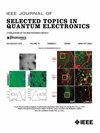Intraoperative Hyperspectral Imaging for Mapping Brain Motor and Sensory Functions With the Measurements of Changes in Hemoglobin Oxygenation and Oxidation of Cytochrome-C-Oxidase
IF 4.3
2区 工程技术
Q1 ENGINEERING, ELECTRICAL & ELECTRONIC
IEEE Journal of Selected Topics in Quantum Electronics
Pub Date : 2025-01-17
DOI:10.1109/JSTQE.2025.3531556
引用次数: 0
Abstract
A neuroimaging technique during surgery can further complement preoperative fMRI and electrical brain stimulation (EBS) to optimize the localization of eloquent areas during glioma resection and could improve dramatically the surgical procedure and patient care. Hyperspectral optical imaging is a non-invasive technique that is able to monitor hemodynamic and metabolic responses during neurosurgery. This technique can be used to complement the cortical functional mapping during neurosurgical procedures. However, a robust quantification of biomarkers of brain functionality is required to assist neurosurgeons. It is also essential to calibrate acquisition devices with robust optical phantoms to test instrument reliability. In this work, we explore the possibility to use a combined liquid blood phantom with cytochrome contained yeast to evaluate the reliability of hyperspectral imaging to measure oxygenation and metabolic changes. We also used hyperspectral imaging for identifying motor and sensory areas of human patients during neurosurgery. The results showed that a blood phantom and commercial yeast can be used to validate the measurement of hemodynamic and metabolic changes. This homogeneous phantom provides an excellent means to verify the reliability of intraoperative optical setups before moving on to clinical application. We showed that a commercial hyperspectral camera combined with a white light illumination could be used for identifying functional brain areas using hemodynamic and metabolic biomarkers. We also observed significant changes of the oxidative state of cytochrome-c-oxidase in periarterial tissue which seems to give an indication of the metabolism of the tissue during cerebral activity.求助全文
约1分钟内获得全文
求助全文
来源期刊

IEEE Journal of Selected Topics in Quantum Electronics
工程技术-工程:电子与电气
CiteScore
10.60
自引率
2.00%
发文量
212
审稿时长
3 months
期刊介绍:
Papers published in the IEEE Journal of Selected Topics in Quantum Electronics fall within the broad field of science and technology of quantum electronics of a device, subsystem, or system-oriented nature. Each issue is devoted to a specific topic within this broad spectrum. Announcements of the topical areas planned for future issues, along with deadlines for receipt of manuscripts, are published in this Journal and in the IEEE Journal of Quantum Electronics. Generally, the scope of manuscripts appropriate to this Journal is the same as that for the IEEE Journal of Quantum Electronics. Manuscripts are published that report original theoretical and/or experimental research results that advance the scientific and technological base of quantum electronics devices, systems, or applications. The Journal is dedicated toward publishing research results that advance the state of the art or add to the understanding of the generation, amplification, modulation, detection, waveguiding, or propagation characteristics of coherent electromagnetic radiation having sub-millimeter and shorter wavelengths. In order to be suitable for publication in this Journal, the content of manuscripts concerned with subject-related research must have a potential impact on advancing the technological base of quantum electronic devices, systems, and/or applications. Potential authors of subject-related research have the responsibility of pointing out this potential impact. System-oriented manuscripts must be concerned with systems that perform a function previously unavailable or that outperform previously established systems that did not use quantum electronic components or concepts. Tutorial and review papers are by invitation only.
 求助内容:
求助内容: 应助结果提醒方式:
应助结果提醒方式:


